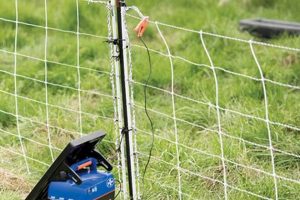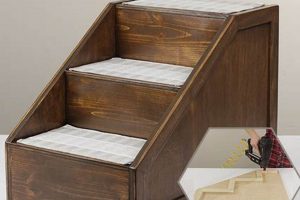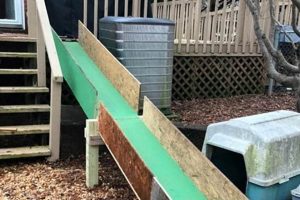A cost-effective, self-constructed inclined plane provides canines, particularly those with mobility issues, small breeds, or senior animals, with a gentler alternative to jumping. This solution offers a safer way to access elevated surfaces such as beds, couches, or vehicles. For example, a ramp can significantly reduce the strain on a dog’s joints when entering a car.
Constructing such a support structure can prevent injuries, ease discomfort from arthritis or other joint conditions, and enhance the overall quality of life for dogs. Historically, individuals have sought solutions to assist animals with physical limitations, and the creation of accessible aids like these represents a continuation of that effort. This option offers a flexible and economical method to address the individual needs of a pet.
The following sections will delve into specific materials, construction techniques, and design considerations necessary to build a functional and safe version of this helpful aid for canine companions, with an emphasis on affordability and ease of assembly.
Construction Recommendations
The following recommendations aim to guide the construction of a supportive and safe structure for canines, emphasizing both fiscal prudence and structural integrity.
Tip 1: Material Selection: Prioritize readily available and repurposed materials, such as reclaimed wood, shipping pallets (ensure they are heat-treated and not chemically treated), or sturdy cardboard for the base structure. The walking surface should be covered with carpet remnants or rubber matting to provide traction and prevent slipping.
Tip 2: Angle Calculation: The incline’s gradient is crucial. A steeper angle increases the risk of falls and joint strain. A gentler slope, though requiring more material, promotes safer and easier access. Consider the dog’s size and physical condition when determining the optimal angle.
Tip 3: Structural Support: Reinforce the ramp’s frame with internal supports, particularly if using less robust materials like cardboard. Wooden supports are advisable for a more durable structure. Proper reinforcement prevents sagging or collapse under the dog’s weight.
Tip 4: Surface Traction: Smooth surfaces present a slip hazard. Securely affixing carpet, rubber mats, or textured paint to the ramp’s surface is essential. These materials provide grip and confidence for the animal during ascent and descent.
Tip 5: Ramp Width: Ensure sufficient width to accommodate the dog’s gait. A narrow structure can lead to instability and potential falls. The width should allow the dog to comfortably walk without the risk of stepping off the edge.
Tip 6: Edge Protection: Consider adding side rails or raised edges to the ramp to prevent the dog from accidentally stepping off the side. This is especially important for dogs with limited vision or those prone to anxiety.
Tip 7: Testing and Adjustment: Before allowing the dog to use the completed ramp unsupervised, thoroughly test its stability and weight-bearing capacity. Observe the dog’s initial interactions with the ramp and make any necessary adjustments to the angle, traction, or support.
Adhering to these recommendations promotes the construction of a cost-effective, safe, and functional aid, enhancing a canine’s access to elevated surfaces while minimizing the risk of injury.
The subsequent sections will provide guidance on specific design considerations and potential modifications to tailor the structure to individual canine needs and owner preferences.
1. Material affordability
The concept of material affordability directly determines the feasibility of constructing an inexpensive dog ramp. The selection of low-cost components is paramount to achieving the “inexpensive” aspect of the project. This necessitates exploring readily available alternatives to commercially manufactured materials, thereby minimizing financial outlay. For instance, utilizing reclaimed lumber from discarded furniture or construction sites, sourcing carpet remnants from local suppliers, or employing durable, repurposed plastics can significantly reduce overall costs.
The cause-and-effect relationship is evident: cost-effective materials lead to a lower-priced ramp. Disregarding material affordability renders the project no longer truly inexpensive, potentially negating its primary benefit for budget-conscious pet owners. Examples of detrimental outcomes include opting for new, premium-grade lumber, which increases the project’s expense substantially, or choosing specialized, non-slip surfaces designed for industrial use, which are far more expensive than readily available household options such as rubber mats or carpet scraps. The practicality lies in enabling a broader demographic to provide their pets with accessible aids, regardless of their financial limitations.
The overall success of creating an inexpensive ramp hinges on prioritizing readily sourced, economically viable materials. While ensuring structural integrity and canine safety remains crucial, inventive material selection proves indispensable in fulfilling the project’s fundamental goal of providing an accessible and affordable solution. The challenge lies in balancing material cost with necessary attributes like durability and grip, demanding careful assessment of trade-offs to achieve the most suitable outcome.
2. Angle adjustability
Angle adjustability is a design feature that enhances the versatility and usability of a self-constructed dog ramp while potentially influencing its overall cost-effectiveness. This attribute allows the ramp to be tailored to varying heights of furniture, vehicles, or other elevated surfaces, accommodating different canine breeds and physical conditions.
- Adapting to Diverse Environments
Adjustable angles enable the ramp to be effectively used in multiple settings, from assisting a small dog onto a low couch to facilitating access to a higher vehicle cargo area. Without this adjustability, a ramp designed for one specific height would be unsuitable for others, limiting its practical application and potentially necessitating the construction of multiple ramps. This adaptability maximizes the investment made in materials and construction time.
- Accommodating Canine Physical Needs
A steeper angle may be challenging for older dogs or those with joint issues, while a gentler slope, though requiring more material, is generally easier to navigate. Angle adjustability allows for optimization based on a dog’s specific needs, preventing strain and potential injury. This is particularly important for breeds prone to hip dysplasia or other mobility limitations. A fixed-angle ramp cannot account for these individual requirements.
- Construction Complexity and Cost Considerations
Implementing an adjustable angle mechanism can introduce complexity to the construction process. Simple designs might involve hinged sections with locking supports, while more advanced options could utilize telescoping elements or threaded rods. The chosen mechanism’s complexity directly impacts material requirements, construction time, and, consequently, the overall expense of the ramp. Therefore, balancing adjustability with cost-effectiveness is crucial. Simpler adjustment methods using basic hardware are preferable to complex, expensive systems.
- Stability and Safety Implications
Any adjustable mechanism must prioritize stability and safety. A poorly designed adjustment system can compromise the ramp’s structural integrity, leading to potential collapses or instability. Locking mechanisms must be robust and reliable to prevent unintended angle changes during use. Regular inspection and maintenance are essential to ensure continued safe operation. A fixed-angle ramp, while less versatile, inherently offers greater structural simplicity and potentially enhanced stability.
Incorporating angle adjustability into a self-made dog ramp enhances its utility and suitability for diverse situations and canine needs. However, integrating this feature requires careful consideration of its impact on construction complexity, cost, and overall structural integrity. The ideal design balances the benefits of adjustability with the imperatives of affordability and safety, ensuring a practical and beneficial aid for canine companions.
3. Surface traction
Surface traction is a critical safety component within the context of an inexpensive DIY dog ramp. The cause-and-effect relationship is direct: insufficient traction leads to slips, falls, and potential injuries, negating the ramp’s intended purpose of providing safer access. A ramp’s low cost becomes irrelevant if it causes harm to the animal it is designed to assist. Real-life examples include ramps constructed with smooth, untreated wood that become hazardous when wet or used by dogs with limited mobility. The practical significance of understanding this connection lies in prioritizing traction enhancement methods, even if they add slightly to the project’s cost, as the safety benefits outweigh the minimal expense.
Several inexpensive methods can improve surface traction. Carpet remnants, secured with staples or adhesive, provide a reliable grip. Rubber mats, often available as surplus or recycled materials, offer excellent non-slip properties. Textured paint or sealant applications can also increase friction. Strategic placement of treads, either purchased or fashioned from spare wood strips, creates defined stepping points. The choice of method should consider the ramp’s intended use environment (indoor or outdoor) and the dog’s individual needs, such as paw size and gait. A ramp leading to a car, for instance, would benefit from a more durable and weather-resistant traction solution than one used solely indoors.
In summary, surface traction is not an optional consideration but a fundamental safety requirement for any self-constructed dog ramp, regardless of its cost. While pursuing affordability, it is essential to prioritize methods of enhancing grip and preventing slips. Failure to do so can compromise the ramp’s functionality and, more importantly, endanger the animal. The balance between cost-effectiveness and adequate traction ensures the ramp effectively fulfills its purpose as a safe and accessible aid for canine companions.
4. Structural stability
Structural stability is paramount in the creation of a cost-effective, self-made dog ramp. The absence of a stable structure renders the ramp unusable and potentially hazardous, regardless of its affordability. This concept directly influences the design, material selection, and construction techniques employed.
- Material Load-Bearing Capacity
The selected materials must possess adequate strength to withstand the anticipated weight of the dog. Utilizing repurposed materials, such as reclaimed wood or sturdy cardboard, necessitates careful evaluation of their structural integrity. For instance, thin or weakened wood may buckle under the dog’s weight, leading to collapse. Appropriately rated lumber or reinforced cardboard construction techniques are essential for ensuring sufficient load-bearing capacity. Neglecting this aspect negates any cost savings if the ramp fails under normal use.
- Joint Reinforcement Techniques
The points where different ramp components connect are critical stress points. Joints must be securely fastened to prevent separation or failure. Techniques such as screwing, gluing, or using metal brackets enhance joint strength. Example: Simply butting two pieces of wood together and relying solely on glue is insufficient for a ramp expected to bear considerable weight. Reinforced joints distribute stress and prevent localized failure, contributing to the ramp’s overall stability. Careful attention to joint construction is crucial, even with inexpensive materials.
- Support Structure Design
The ramp’s underlying support structure plays a vital role in distributing weight evenly and preventing sagging. For longer ramps, internal supports or bracing are essential. Example: A ramp spanning a significant distance without any central supports will likely bow or deflect under load. Strategically placed supports, whether vertical or angled, provide additional rigidity and prevent deformation. The design of the support structure must account for the ramp’s length, width, and expected weight-bearing capacity.
- Base Stability and Ground Contact
The ramp’s base must provide a stable and level platform. Uneven ground contact can create instability and increase the risk of tipping. Adjustable feet or a wide, solid base can compensate for minor ground irregularities. Example: A ramp placed on an uneven surface may wobble or shift, making it difficult and unsafe for the dog to use. A stable base ensures that the ramp remains firmly in place, regardless of the dog’s movements. Proper base design is fundamental to the ramp’s overall stability and safety.
In conclusion, structural stability is an indispensable element of an inexpensive, self-constructed dog ramp. Careful material selection, robust joint reinforcement, a well-designed support structure, and a stable base are all essential for creating a safe and functional aid. Compromising on structural integrity to reduce costs is a false economy, as it jeopardizes the ramp’s usability and poses a potential hazard to the animal.
5. Size appropriateness
Size appropriateness is a non-negotiable element in the successful execution of a cost-effective, self-constructed dog ramp project. An improperly sized ramp, regardless of its low cost, fails to serve its intended purpose and can even be detrimental to the animal’s well-being. The connection between size and functionality is direct: a ramp too short may create an excessively steep angle, defeating the purpose of easing access, while a ramp too narrow presents a falling hazard. A design too large consumes unnecessary materials, undermining the “inexpensive” objective. Real-life illustrations include constructing a short, steep ramp for a senior dog with arthritis, which exacerbates joint pain, or building a narrow ramp for a large breed, increasing the risk of falls. The practical understanding emphasizes tailoring dimensions to the individual dog’s size, breed, and physical capabilities.
Determining appropriate dimensions involves several considerations. Ramp length should be proportional to the height it needs to reach, ensuring a manageable incline. Width must accommodate the dog’s gait comfortably. Height should match the target surface (bed, couch, vehicle) precisely. Furthermore, potential design adjustments may optimize utility. A folding or telescoping ramp, though potentially increasing complexity and cost, provides portability and adaptable sizing for diverse situations. Alternatively, a modular ramp system allows for adjustable length and angle configurations. Careful consideration of these aspects leads to designs that provide customized comfort and ease of use and enhance their overall value.
In summary, size appropriateness constitutes a core parameter within the design and construction of an inexpensive, self-made dog ramp. Balancing customized dimensions with cost-effective construction ensures that the final product provides safe, effective, and affordable assistance to canine companions. The challenge lies in accurately assessing the dog’s needs and translating them into precise measurements, resulting in a ramp optimized for both comfort and practicality.
6. Portability
Portability significantly enhances the utility of a self-constructed, cost-effective dog ramp. This attribute allows for convenient relocation of the ramp between different areas of a home or transportation for use in vehicles or during travel. However, achieving portability often necessitates design compromises that balance ease of movement with structural integrity and affordability.
- Weight and Material Selection
The weight of the ramp directly impacts its ease of transport. Lighter materials, such as specific types of plywood or reinforced cardboard, contribute to portability but may compromise the ramp’s weight-bearing capacity and durability. Choosing heavier, more robust materials improves structural stability but reduces portability. Therefore, material selection must carefully weigh the trade-offs between weight and strength. The goal is to minimize weight without sacrificing the ramp’s ability to safely support the dog.
- Folding or Collapsible Designs
Incorporating a folding or collapsible mechanism significantly enhances portability. Hinged sections allow the ramp to be folded into a more compact form for storage and transport. However, adding hinges and locking mechanisms increases construction complexity and may add to the overall cost. Simple, robust hinge designs are preferable to elaborate, expensive systems. The folding mechanism must be reliable and secure to prevent accidental collapses during use.
- Handle Integration
Integrating a handle or grip facilitates carrying the ramp. A simple handle made from rope or a more elaborate handle made from wood or metal can be attached to the ramp’s side. Handle placement should consider the ramp’s center of gravity to ensure balanced carrying. The handle should be securely fastened to the ramp’s frame to prevent detachment. The addition of a handle is a low-cost way to significantly improve the ramp’s portability.
- Size and Dimensional Constraints
The ramp’s overall size and dimensions impact its portability. A longer ramp, while providing a gentler slope, is inherently less portable than a shorter ramp. The ramp’s width also influences ease of handling. Designing the ramp with reasonable dimensions, based on the dog’s size and the intended use environment, is critical for optimizing portability. Consideration should be given to fitting the ramp into car trunks or storage areas.
In conclusion, portability is a valuable attribute for a self-made, cost-effective dog ramp. Achieving portability necessitates careful consideration of material selection, design features such as folding mechanisms and handles, and overall size constraints. Balancing these factors ensures that the ramp is both easy to transport and capable of providing safe and reliable assistance for canine companions in various settings. Compromising on structural integrity in pursuit of extreme portability is counterproductive, as the ramp’s primary function is to provide safe access.
7. Easy assembly
The characteristic of easy assembly is intricately linked to the overarching goal of an inexpensive DIY dog ramp. The degree of assembly complexity directly influences the time investment and skill level required, thus impacting the overall cost-effectiveness. A design necessitating specialized tools or advanced construction techniques diminishes accessibility, potentially forcing individuals to seek professional assistance, which contradicts the “inexpensive” premise. A ramp requiring complex joinery or intricate cutting patterns exemplifies this, increasing both material waste and labor cost. Conversely, a design emphasizing straightforward construction methods, such as using pre-cut lumber or simple screw-together joints, promotes accessibility for a wider range of individuals with varying skill sets. The practical significance lies in empowering pet owners to create a functional aid without incurring undue expenses or requiring specialized expertise.
Furthermore, easy assembly translates into a reduction of potential errors during the construction process. Complex designs increase the likelihood of misaligned joints, incorrect cuts, or improperly fastened components, resulting in wasted materials and a compromised final product. Designs that prioritize simplicity and clarity in instructions mitigate these risks, ensuring a more successful and cost-effective outcome. For example, instructions featuring step-by-step diagrams with clearly labeled components are more conducive to error-free assembly than vague or ambiguous directions. This reduction in errors saves both time and money, contributing to the project’s overall affordability.
In summary, easy assembly is a crucial component of an inexpensive DIY dog ramp. Simplified construction techniques, clear instructions, and readily available tools are essential for maximizing accessibility and minimizing both time investment and potential errors. By prioritizing ease of assembly, the project remains within reach for a broader range of individuals, ensuring that the ramp fulfills its intended purpose as a cost-effective and practical aid for canine companions. Challenges in balancing easy assembly with structural integrity must be addressed through careful material selection and thoughtful design considerations, ensuring a safe and functional final product.
Frequently Asked Questions
This section addresses common inquiries and misconceptions regarding the design, construction, and implementation of cost-effective, self-made ramps for canine use. These questions aim to provide clarity and guidance for individuals seeking to build a functional and safe aid for their pets.
Question 1: What are the minimum material requirements for a structurally sound, low-cost ramp?
The minimum requirements include a supporting frame (reclaimed wood, sturdy cardboard), a walking surface (carpet remnant, rubber matting), fasteners (screws, adhesive), and potentially, internal supports for added strength. The precise quantities depend on the ramp’s dimensions.
Question 2: How is the optimal ramp angle determined for a specific dog’s needs?
The angle depends on the dog’s size, age, and physical condition. A shallower angle (lower incline) is preferable for older dogs or those with joint issues. A steeper angle, while requiring less material, may present difficulties for dogs with limited mobility. Observation of the dog’s gait and consultation with a veterinarian are advisable.
Question 3: What safety precautions are essential during the construction process?
Safety precautions include wearing appropriate personal protective equipment (safety glasses, gloves), using power tools responsibly, and ensuring a stable work surface. Proper ventilation is necessary when using adhesives or paints. Sharp edges should be smoothed to prevent injury to the dog or owner.
Question 4: How does one prevent slippage on the ramp’s walking surface?
Slippage can be prevented by securely attaching non-slip materials, such as carpet remnants or rubber mats, to the ramp’s surface. Textured paint or adhesive strips also provide added traction. Regular inspection and replacement of worn traction materials are essential.
Question 5: What are the potential risks associated with using repurposed materials?
Potential risks include structural weakness, contamination with harmful substances (chemicals, mold), and the presence of sharp edges or splinters. Thorough inspection and cleaning of repurposed materials are essential. Materials treated with harmful chemicals should be avoided altogether.
Question 6: How should one introduce a dog to a newly constructed ramp?
Introduction should be gradual and positive. Using treats or verbal encouragement, guide the dog up and down the ramp. Avoid forcing the dog, and allow it to acclimate at its own pace. Short, frequent training sessions are more effective than long, stressful ones.
Proper construction and careful introduction are essential for ensuring the ramp’s effectiveness and safety. Prioritizing the dog’s well-being throughout the process is paramount.
The subsequent section provides concluding remarks and reinforces the core principles discussed in this guide.
Conclusion
The preceding analysis has explored the multifaceted aspects of constructing a cost-effective, self-made aid for canines, from material selection to assembly techniques. Structural integrity, surface traction, appropriate sizing, and ease of construction are paramount. These elements directly impact the functionality, safety, and long-term utility of the ramp.
The decision to undertake the construction of an inexpensive diy dog ramp requires careful consideration of the animal’s specific needs and the builder’s capabilities. Prioritizing safety and adherence to established guidelines are essential for creating a beneficial and lasting solution. Thorough research and diligent execution ensure a positive outcome for both canine and owner.







